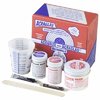Is the barrel free floated and do you have any kind of indication about how accurate it was pre repair (groups etc. )? I am guessing from the wood that it is a stained beech stock which means depending on the repair needed, you may have to refinish around the repair. Others will probably also post but 1) it is fixable, 2) it may not be as accurate post fix without some additional work, and 3) are replacement stocks available if you mess up.
The weakest fix is simply using a very good wood glue (in heavens name no foaming resin type glue like Gorilla Glue) and clamping it. You will need to actually wedge the crack a bit to open it to the wood glue--thinner glue generally wicks better but is weaker. The thick glue resists wicking into the crack so it may have to be manually applied. A way to strengthen that repair is to use some sort of threaded rod--preferably one that does not rust, you will have to work within the barrel channel if you do not want the repair seen so the stock is going to have to be dismounted from the action. Cut a wood slot in the barrel channel (dremel, hobby knife, oscillating saw, whatever), lay the cleaned (acetone, etc.) threaded rod in the slot across the crack, use clear epoxy to cover the threaded rod (even a small bolt with a nut works). The old time version of this is to use brass threaded rod, drill a hole through the crack, apply glue/epoxy/etc. to the threaded rod and inside the hole across the stock, screw the rod through the hole, clamp, etc. after the glue sets, cut the rod on both sides, use a file to file it down to the level of the wood, refinish the wood in those two areas. It will be seen, but may add "character" to the rifle.
You can use acraglas which is a two part resin based adhesive--spread the crack, apply, clamp, and make sure to cover areas on the stock's surface with paste wax, or some other epoxy. Acraglas has a brownish tint so it does blend into dark wood, resembling wood grain, you can add a black colorant to it. You can also use epoxy alone available at any hardware store--use the type specified for wood--make sure crack is clean, apply, clamp, etc. Clear epoxies rather than gray JB weld are easier to hide.
If your barrel is freefloated, the fix may not affect your POI and accuracy or it may depending on workmanship, receiver bedding,etc. You may have to go ahead and glass bed the rifle after the fix or even use full barrel channel bedding. If your barrel depends on upward pressure from the stock for accuracy, then you can have a problem--you will need a stronger type fix than the simply glue one as it will probably try to split again at the same location and the fix is under constant pressure. Getting the pressure right is also an individual rifle thing and may take trial and error to restore the rifle to its former glory.
Fancy fixes include bowties inlaid across the crack, wood dowels instead of brass threaded rod in the drilled hole (don't use oak or pine dowels--I have had good luck with bamboo bbq kebab sticks at Walmart for that purpose. Bamboo is a tough material that resists cracking which is what you want, and so on. Wood dowels are less obtrusive and easier to blend in to the existing rifle stock's finish. You can get a dot sander from an automotive paint supply store that allows you to sand about 1/4 inch or so in diameter, use toothpicks and pointed swabs to apply small amounts of matching stain, top dress with poly/shellac/etc. Let me know if you want more specifics on a fix, I am just trying to point out a few options.
A THR poster, GunnyUSMC did stock repair on firearms--do a google search for Candyman and rifle stock repair. He documented each step of various repairs with photos and does amazing work.






